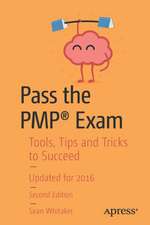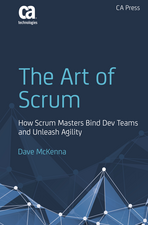The Business Savvy Project Manager
Autor Gary Heerkensen Limba Engleză Hardback – 16 dec 2005
To make the leap from average to superior, you must develop the skills to manage each project like a small business. The Business-Savvy Project Manager thoroughly explains key concepts, principles, and tools for project managers to provide organizations with superior return-oninvestment and top performance. From portfolio management and strategic alignment to calculation of economic metrics and effective use of both financial and nonfinancial criteria in project proposals, it gives you the business savvy for top-level performance and certain career success.
Preț: 308.03 lei
Preț vechi: 339.68 lei
-9% Nou
Puncte Express: 462
Preț estimativ în valută:
58.96€ • 64.07$ • 49.56£
58.96€ • 64.07$ • 49.56£
Carte tipărită la comandă
Livrare economică 18-29 aprilie
Preluare comenzi: 021 569.72.76
Specificații
ISBN-13: 9780071443074
ISBN-10: 007144307X
Pagini: 366
Dimensiuni: 158 x 231 x 35 mm
Greutate: 0.73 kg
Editura: McGraw Hill Education
Colecția McGraw-Hill
Locul publicării:United States
ISBN-10: 007144307X
Pagini: 366
Dimensiuni: 158 x 231 x 35 mm
Greutate: 0.73 kg
Editura: McGraw Hill Education
Colecția McGraw-Hill
Locul publicării:United States
Cuprins
Introduction
Permissions
Part One Building Foundational Knowledge
Chapter 1 Project Management as a Business Function
A Few Revelations as We Begin…
The Landscape of Project Management Is Changing
How Expectations of Projects Are Changing
How Expectations of Project Managers Are Changing
How the Definition of Project Success Is Changing
Some Other Significant Changes
Adopting a Total Asset Life Cycle Focus
So…How Are Projects Connected to the “Bottom Line,” Anyway?
Chapter 2 The Core of Business Knowledge: Finance and Accounting
Finance: The Basics
What Is Financial Management?
How Are Projects Financed?
The Weighted Average Cost of Capital
The Cash Management Cycle
Accounting: The Basics
What is GAAP?
Measuring Financial Health: The Balance Sheet
Measuring Profit: The Income Statement
Measuring the Way Money Moves: The Cash Flow Statement
Making Sense of Financial Statements by Using Ratio Analysis
Financial Accounting versus Managerial Accounting
Chapter 3 Fundamentals of Organizational Management
What Is Organizational Management?
Historical Perspectives
Sound Organizational Management through Sound Organizational Planning
Elements of Strategic Planning
Primary Competitive Strategy
Situation Analysis
Elements of Tactical Planning
Competitive Advantage
Structural Design
Elements of Operational Planning
Overarching Linkages in Organizational Planning
Information Management Configuration
Business Process Management
The Value Chain of Business Functions
How Organizations Improve their Business Processes
Chapter 4 Cost Management in Organizations
Organizational Budgeting and Control
The Basic Process of Budgeting
The Master Budget
Relating the Master Budget to Projects
The Responsibility Center: Concept and Practice
About Cost Accounting Systems
Fixed Costs, Variable Costs, and Mixed Costs
Costs Related to Management and Operations
Costs Related to Quality Management
Costs Related to Buying and Selling
Costs Related to Project Economics
Part Two Applying Sound Business Practices at the Enterprise Level
Chapter 5 Project Portfolio Management, Phase I: Identifying the “Right” Business Initiatives
About the Process of Capital Budgeting
Project Portfolio Management: Moving in the Direction of Business
The Benefits of Using a Project Portfolio Management Approach
Guiding Principles of the Project Portfolio Management Approach
The Basic Building Blocks of the Project Portfolio Management Processes
Project Portfolio Management: A Three-Phase Process
Project Portfolio Management: Step by Step
Phase I: Identifying, Quantifying, and Financing the Right Business Initiatives
The Start of Portfolio Development: Identifying Long-Range Goals
Identifying Quantified Business Initiatives (Strategic and Operational)
Establishing a Project Financing Strategy
How Can You Be Sure You Have a Sound Approach to Identifying the “Right” Initiatives?
The Biggest Challenge in Identifying the “Right” Initiatives: Knowing When to Stop
Chapter 6 Project Portfolio Management, Phase II: Identifying, Categorizing, and Prioritizing Project Solutions
Identifying Solutions to Address Business Initiatives
Introduction to the Alternative Identification and Analysis Process
Alternative Identification and Analysis: Step by Step
Configuring the Portfolio Categories
Prioritizing Projects within Portfolio Categories: Why and How
An Overview of the Attribute Scoring Methodology
Putting It All Together: The Weighted Factor Scoring Matrix
Chapter 7 Project Portfolio Management, Phase III: Selecting, Launching, and Coordinating Projects
The Project Listing Process: A Review
Selecting the Best Projects and Constructing the Final Portfolio Listing
Understanding the Difference between Justification, Selection, and Authorization
Avoiding the “Selected, but Not Justified” Syndrome
Applying Project Screening Techniques
Guidelines for Administering an Effective Project Prioritization Process
Knowing Where to “Draw the Line: It’s All about Limitations
Conducting a Final Portfolio Review
Developing a Project Launch Sequence
Considerations During Project Initiation
Conduct Post-Project (and Portfolio) Audits
Part Three Applying Sound Business Practices at the Project Level
Chapter 8 Project Economics, Part I: Foundational Principles
The Time Value of Money
Future Value and Compounding
Present Value and Discounting
Three Methods for Calculating the Time Value of Money
Rate of Return: The Basics
Discounted Cash Flow Methodology
Chapter 9 Project Economics, Part II: Preparing for a Project Financial Analysis
The Anatomy of Project Cash Flow
The Foundation of Any Financial Analysis: The Cash Flow Chart
The Process of Identifying and Modeling the Cash Flows of a Project
Guidelines for Modeling Cash Flows
Proper Treatment of Special Cash Flow Types
Three Basic Project Cash Flow Models
Chapter 10 Project Economics, Part III: Performing a Project Financial Analysis
Separating Fact from Fiction in the Project Financial Analysis Process
The Four Basic Financial Metrics
Performing a Project Financial Analysis: A Comprehensive Example
Calculating the Four Basic Financial Metrics
Putting the Financial Metrics Together: Evaluating the Investment
Financial Analysis in Reverse: Calculating the Maximum Justifiable Project Cost
Enhancing the Financial Analysis Process by Introducing Risk
Chapter 11 Risk Management, Decision-Making, and Business
The Objectives of Risk Management and Decision-Making
Dealing with Risk and Uncertainty in Business Decisions
Risk and Uncertainty: A Quick Refresher
Sources of Business and Financial Uncertainty in Project Investment Decisions
Reducing Risk by Using Higher-Quality Information
Reducing Risk by Modifying Financial Analysis Process Parameters
Using Sensitivity Analysis as Part of the Financial Analysis Process
Identifying the Appropriate Variables for a Sensitivity Analysis
Performing a One-Dimensional Sensitivity Analysis
Performing a Multidimensional Sensitivity Analysis
Performing Sensitivity Analysis using Monte Carlo Simulation
Using Break Even Analysis for Business Decisions
Using Decision Trees in Financially Based Decision-Making
Part Four Preparing the Business Case
Chapter 12 Business Cases and Business Case Preparation
Why Use a Business Case Approach?
What Is a Business Case?
General Applications of Business Cases
Benefits of Using a Formal Business Case Approach
Conditions that Trigger a Formal Business Case Approach
Who Prepares the Business Case?
The Business Case Development Process
Critical Success Factors in Business Case Development
Qualities of a Well-Prepared Business Case
Recommended Business Case Structure: An Overview
Part Five Appendixes
Appendix A Guidelines for Preparing a Project Business Case
Appendix B Interest Tables
Glossary
Index
Permissions
Part One Building Foundational Knowledge
Chapter 1 Project Management as a Business Function
A Few Revelations as We Begin…
The Landscape of Project Management Is Changing
How Expectations of Projects Are Changing
How Expectations of Project Managers Are Changing
How the Definition of Project Success Is Changing
Some Other Significant Changes
Adopting a Total Asset Life Cycle Focus
So…How Are Projects Connected to the “Bottom Line,” Anyway?
Chapter 2 The Core of Business Knowledge: Finance and Accounting
Finance: The Basics
What Is Financial Management?
How Are Projects Financed?
The Weighted Average Cost of Capital
The Cash Management Cycle
Accounting: The Basics
What is GAAP?
Measuring Financial Health: The Balance Sheet
Measuring Profit: The Income Statement
Measuring the Way Money Moves: The Cash Flow Statement
Making Sense of Financial Statements by Using Ratio Analysis
Financial Accounting versus Managerial Accounting
Chapter 3 Fundamentals of Organizational Management
What Is Organizational Management?
Historical Perspectives
Sound Organizational Management through Sound Organizational Planning
Elements of Strategic Planning
Primary Competitive Strategy
Situation Analysis
Elements of Tactical Planning
Competitive Advantage
Structural Design
Elements of Operational Planning
Overarching Linkages in Organizational Planning
Information Management Configuration
Business Process Management
The Value Chain of Business Functions
How Organizations Improve their Business Processes
Chapter 4 Cost Management in Organizations
Organizational Budgeting and Control
The Basic Process of Budgeting
The Master Budget
Relating the Master Budget to Projects
The Responsibility Center: Concept and Practice
About Cost Accounting Systems
Fixed Costs, Variable Costs, and Mixed Costs
Costs Related to Management and Operations
Costs Related to Quality Management
Costs Related to Buying and Selling
Costs Related to Project Economics
Part Two Applying Sound Business Practices at the Enterprise Level
Chapter 5 Project Portfolio Management, Phase I: Identifying the “Right” Business Initiatives
About the Process of Capital Budgeting
Project Portfolio Management: Moving in the Direction of Business
The Benefits of Using a Project Portfolio Management Approach
Guiding Principles of the Project Portfolio Management Approach
The Basic Building Blocks of the Project Portfolio Management Processes
Project Portfolio Management: A Three-Phase Process
Project Portfolio Management: Step by Step
Phase I: Identifying, Quantifying, and Financing the Right Business Initiatives
The Start of Portfolio Development: Identifying Long-Range Goals
Identifying Quantified Business Initiatives (Strategic and Operational)
Establishing a Project Financing Strategy
How Can You Be Sure You Have a Sound Approach to Identifying the “Right” Initiatives?
The Biggest Challenge in Identifying the “Right” Initiatives: Knowing When to Stop
Chapter 6 Project Portfolio Management, Phase II: Identifying, Categorizing, and Prioritizing Project Solutions
Identifying Solutions to Address Business Initiatives
Introduction to the Alternative Identification and Analysis Process
Alternative Identification and Analysis: Step by Step
Configuring the Portfolio Categories
Prioritizing Projects within Portfolio Categories: Why and How
An Overview of the Attribute Scoring Methodology
Putting It All Together: The Weighted Factor Scoring Matrix
Chapter 7 Project Portfolio Management, Phase III: Selecting, Launching, and Coordinating Projects
The Project Listing Process: A Review
Selecting the Best Projects and Constructing the Final Portfolio Listing
Understanding the Difference between Justification, Selection, and Authorization
Avoiding the “Selected, but Not Justified” Syndrome
Applying Project Screening Techniques
Guidelines for Administering an Effective Project Prioritization Process
Knowing Where to “Draw the Line: It’s All about Limitations
Conducting a Final Portfolio Review
Developing a Project Launch Sequence
Considerations During Project Initiation
Conduct Post-Project (and Portfolio) Audits
Part Three Applying Sound Business Practices at the Project Level
Chapter 8 Project Economics, Part I: Foundational Principles
The Time Value of Money
Future Value and Compounding
Present Value and Discounting
Three Methods for Calculating the Time Value of Money
Rate of Return: The Basics
Discounted Cash Flow Methodology
Chapter 9 Project Economics, Part II: Preparing for a Project Financial Analysis
The Anatomy of Project Cash Flow
The Foundation of Any Financial Analysis: The Cash Flow Chart
The Process of Identifying and Modeling the Cash Flows of a Project
Guidelines for Modeling Cash Flows
Proper Treatment of Special Cash Flow Types
Three Basic Project Cash Flow Models
Chapter 10 Project Economics, Part III: Performing a Project Financial Analysis
Separating Fact from Fiction in the Project Financial Analysis Process
The Four Basic Financial Metrics
Performing a Project Financial Analysis: A Comprehensive Example
Calculating the Four Basic Financial Metrics
Putting the Financial Metrics Together: Evaluating the Investment
Financial Analysis in Reverse: Calculating the Maximum Justifiable Project Cost
Enhancing the Financial Analysis Process by Introducing Risk
Chapter 11 Risk Management, Decision-Making, and Business
The Objectives of Risk Management and Decision-Making
Dealing with Risk and Uncertainty in Business Decisions
Risk and Uncertainty: A Quick Refresher
Sources of Business and Financial Uncertainty in Project Investment Decisions
Reducing Risk by Using Higher-Quality Information
Reducing Risk by Modifying Financial Analysis Process Parameters
Using Sensitivity Analysis as Part of the Financial Analysis Process
Identifying the Appropriate Variables for a Sensitivity Analysis
Performing a One-Dimensional Sensitivity Analysis
Performing a Multidimensional Sensitivity Analysis
Performing Sensitivity Analysis using Monte Carlo Simulation
Using Break Even Analysis for Business Decisions
Using Decision Trees in Financially Based Decision-Making
Part Four Preparing the Business Case
Chapter 12 Business Cases and Business Case Preparation
Why Use a Business Case Approach?
What Is a Business Case?
General Applications of Business Cases
Benefits of Using a Formal Business Case Approach
Conditions that Trigger a Formal Business Case Approach
Who Prepares the Business Case?
The Business Case Development Process
Critical Success Factors in Business Case Development
Qualities of a Well-Prepared Business Case
Recommended Business Case Structure: An Overview
Part Five Appendixes
Appendix A Guidelines for Preparing a Project Business Case
Appendix B Interest Tables
Glossary
Index





















